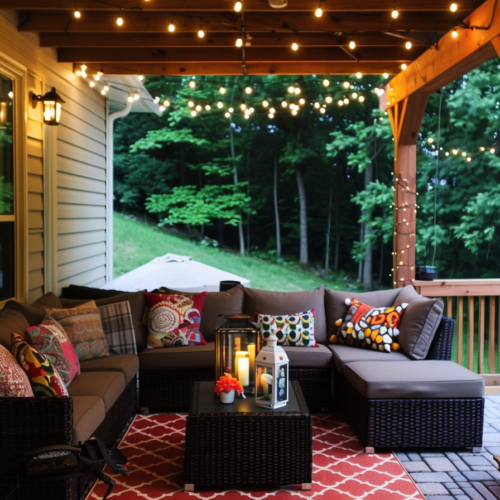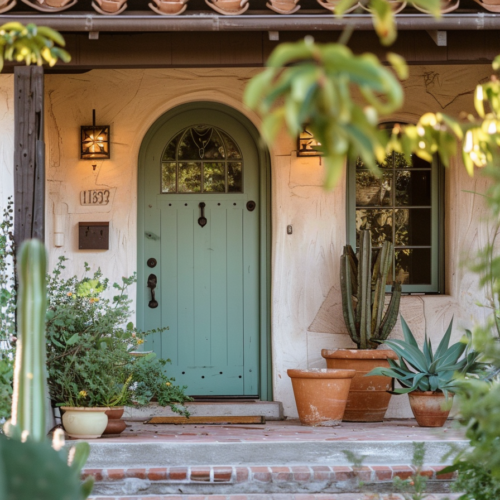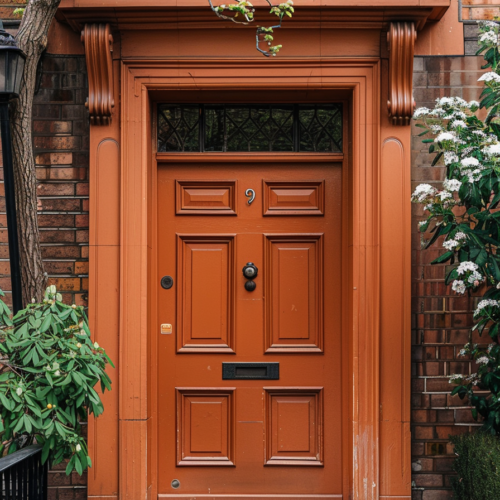When it comes to minimalism, there’s no better place to look to for inspiration than Japan.
Japanese minimalism is embedded in the culture and society, and there’s a lot we can learn from it.
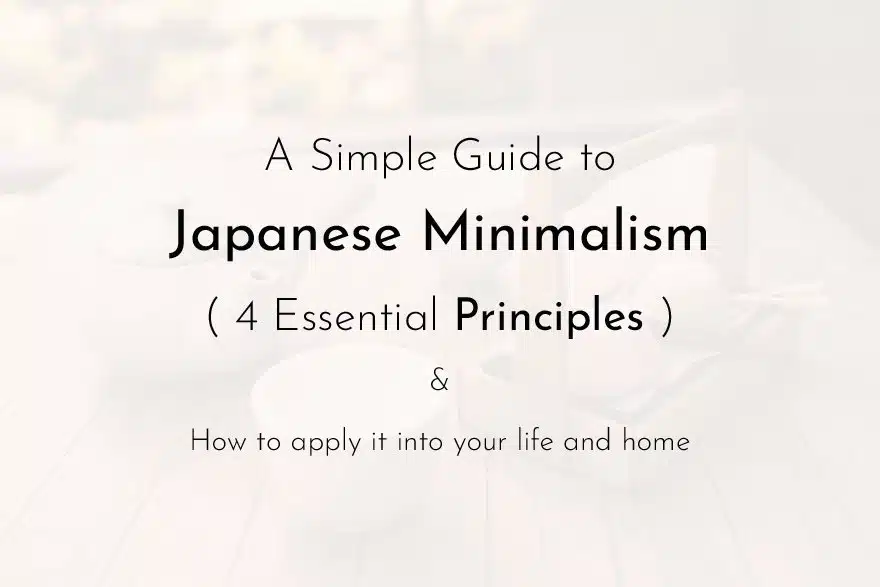
You’ll find some similarities between Scandinavian and Japanese minimalism. Both aesthetics focus on simplicity and practical designs, clean shapes, and negative space.
Natural materials are another essential element in this minimalist aesthetic.
But there are a few key differences, too. We can learn a lot from the minimalist living Japan embodies, and you can apply these lessons to your own life.
Japanese homes tend to be functional, simple, yet attractive. As a densely populated country, Japanese people have learned to make the most of their space, as it’s at a premium.
But minimalism goes deeper into the Japanese culture. You can see how it permeates every aspect of life.
It affects everything from food and time management to Japanese minimalist fashion.
So, let’s take a closer look at the principles of Japanese minimalism. Then, I’ll share some tips on how you can apply this minimalist aesthetic to your own life.
The History of Minimalism in Japan
It’s difficult to know when minimalism first developed in Japan. This movement has a rich and complicated history.
It’s possible to see examples of minimalism in pottery dating back as far as the 12th century.
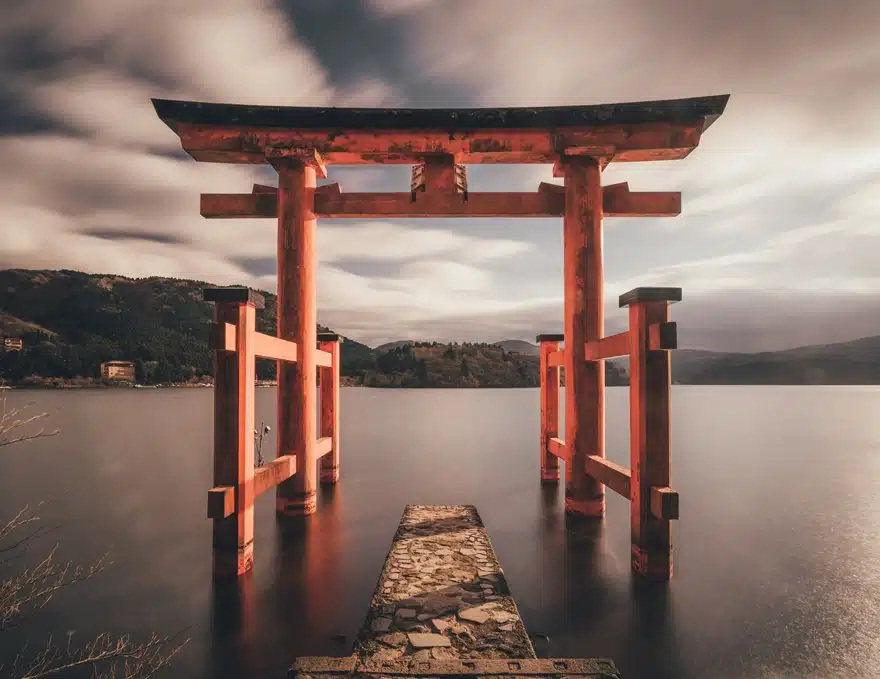
Image / Tianshu Liu
Zen Buddhism inspired an aesthetic way of life. It encouraged people not to overindulge in physical possessions.
But it was only in the 19th century that Japanese minimalism became more widespread. It really picked up in the post-war era of the 1950s and has become accepted throughout society. [1]
4 Essential Principles of Japanese minimalism & Aesthetic
To understand Japan’s minimalist aesthetic, you need to see how these concepts work. They are the essential foundations of aesthetic in Japan.
Wabi: Simple
Wabi refers to a simple, natural type of beauty. It’s not flawless or perfect, as beauty is often depicted in the Western world.
Instead, wabi accepts the natural imperfections that come with life.
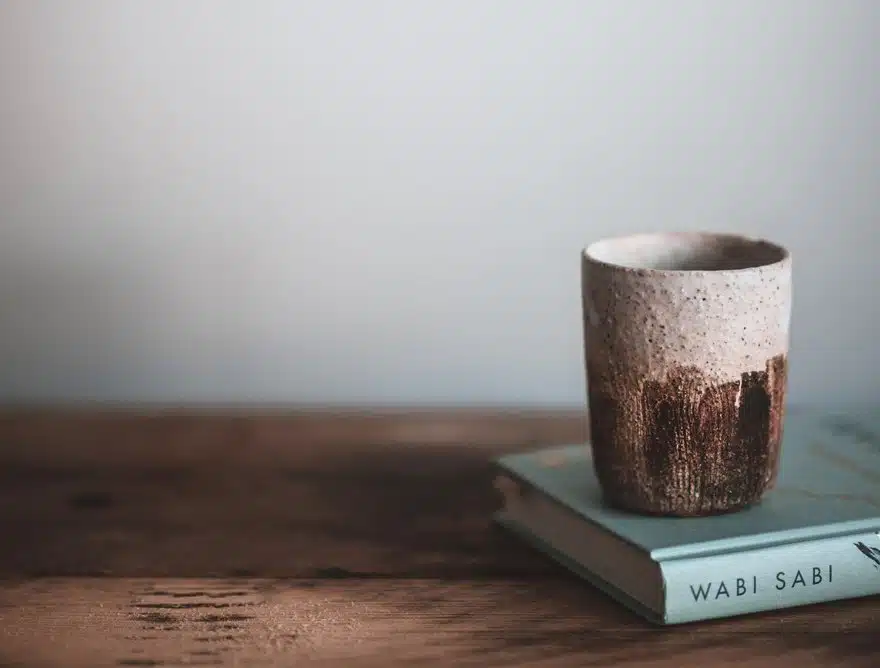
Image / Annie Spratt
You’ll often find wabi combined with another principle that adds even more depth. Sabi is often translated as rustic.
Together, ‘wabi-sabi’ speaks of beauty that becomes less perfect over time.
Wabi-sabi accepts that items will wear away and become broken. But even then, they are still beautiful. We should appreciate them even more for having stood the test of time.
Wabi fits with the Japanese minimalist focus on function and practicality. While things should look visually appealing, they don’t have to be perfect.
Another example of wabi-sabi in practice is kintsugi. It’s the Japanese art of repairing broken pottery with gold or silver. The result is something imperfect but even more beautiful.
Shibui: Subtle
Shibui is the idea of subtle beauty – a principle that fits with Japanese minimalism as a way of living. It’s a modest, everyday kind of beauty that doesn’t have to be loud or showy.
Shibui isn’t bright, complicated, or luxurious. It’s the celebration of a simple and elegant style.
It can also refer to something practical with simple beauty. It gets the job done, and that in itself is worthy of admiration.
Iki: Refined
Iki is a refined and effortless style and beauty. As iki combines with the other principles of Japanese minimalism, it isn’t bold or radical.
Instead, iki seems stylish without even trying. Just like if you naturally have good taste, you don’t have to work at it.
You can see iki in Japanese art and interior design, but most of all in fashion. Japanese people pride themselves on looking good in an elegant and understated way.
Iki, shibui, and wabi combine to create a uniquely Japanese, minimalist form of beauty.
Danshari: Refuse, Dispose, Separate
The final key principle of the Japanese aesthetic is danshari.
It’s essential to the ‘less is more’ concept of Japanese minimalism. You can roughly translate it as ‘refuse, dispose, and separate.’
Danshari is the Japanese form of decluttering. It forms the basis of the famous KonMari method.
To live minimally, you need to clear out the clutter and create negative space. The idea is that by removing what you don’t need, you can better appreciate what you do have.
And while it relates to your possessions, it should also filter into every aspect of your life.
How to apply Japanese minimalism into your life and home
Now, you know the foundations of Japanese minimalism, and you want to apply it to your own life. Here are some simple steps you can take to create a minimalist home and life for yourself.
Think Less is More
Minimalism encourages you to think about whether you need all the items in your home.
To nurture that love of negative space, you need to remove the clutter and make way for empty space.
‘Less is more’ can refer to more than your surroundings. You can apply this smart concept to remove any unnecessary or wasteful things in your life.
That could be social media, apps on your phone, or wasted time tidying up items you don’t need.
Once you realize that you don’t need to keep all these things in your life, you’ll feel freer. You may get huge relief from cutting out all your unnecessary items.
If you want to find out how to declutter a room, read my simple guide here. Start small and work on one area of your house at a time, and you’ll soon have a calm, minimalist home.
Love the Negative Space
In art and graphic design, the negative space is just as important as what’s actually on the page.
The Japanese even have a name for this concept, ‘Ma Ma’. It refers to – and celebrates – the white space between objects rather than the objects themselves.
You can apply the concept of Ma Ma to anything from design to music, poetry, and literature. Because without the negative space, everything would be in chaos.
The negative space allows the items you do have to shine. In a cluttered house, your objects will compete with each other, and you can’t appreciate them at their best.

Image / Masaaki Komori
But against a clean backdrop, you can see each item in all its glory. So, it’s time to put the danshari principle into action and dispose of anything you don’t need.
To embrace negative space in your home, clear your surfaces of anything non-essential. Don’t skip your walls, either.
Choose one or two beautiful pieces of artwork and remove everything else. You’ll notice them more when they’re not hidden among lots of visual clutter.
Embrace a simple diet
You can also apply Japanese minimalism to your diet to save you time and feel healthier. Plus, it will free up your mental space for what you need to focus on most.
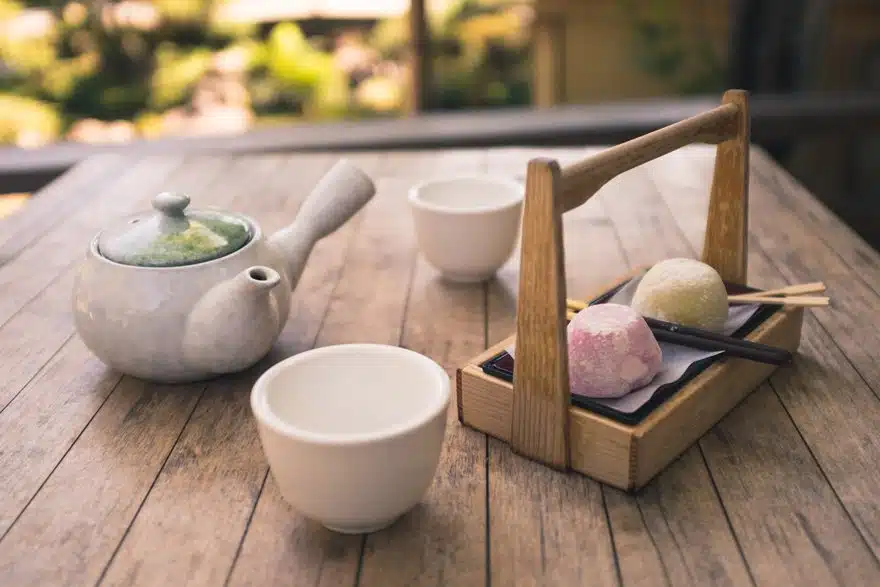
Image / Chris Lawton
In Japan, you won’t find people snacking in between meals. Instead, most Japanese people eat three filling, nutritious meals a day. Then, they don’t feel the need to graze or snack.
It sounds simple – almost too simple. But a Japanese minimalist diet will keep you feeling full and supply you with all the nutrients you need.
It’s easier to stay fit and healthy when you eat a simple diet. It will also save you a lot of time and money.
But the biggest benefit could be that you’ll no longer have to ask yourself, ‘What should I eat for my next meal?’.
You’ll cut down on decision fatigue and free up your mental space for what really matters.
Steamed rice and miso soup are staples of every Japanese meal, even breakfast. Other key components include vegetables and a form of protein. That could be fish, meat, egg, or tofu.
Unlike in the West, every meal is delicious, nutritious, and shouldn’t be rushed. That’s true even (or especially) for breakfast.
You can embrace a simple diet inspired by Japanese food. All you have to do is prepare some basic meals using a few different ingredients.
You don’t need to overcomplicate things with new and exciting recipes every day. Instead, focus on taking time to enjoy what you eat.
As a result, you’ll feel healthier and appreciate your food more, so you’ll be less likely to overeat.
Simplify your Lifestyle
So, you’ve created a beautiful minimalist home for yourself. But Japanese minimalism can (and should) go just beyond your physical surroundings.
You should also cut out time-wasting activities or toxic relationships. You can ask yourself that well-known question, ‘Does it bring you joy?’
If the answer is no, then it’s time to remove it from your life. The same goes if it brings you stress or guilt.
We only have limited time and brain capacity. You don’t want to waste either on things you don’t need.
Instead, you need to align with your values and spend your time on what matters most to you.
If you ‘re not sure how to simplify your lifestyle, start by imagining your ideal life. How would you spend your time? Where do you want your focus to be?
Then, work out what you need to remove to make that ideal life a reality!
Tip: save the image below to your Pinterest to re-read this article later!
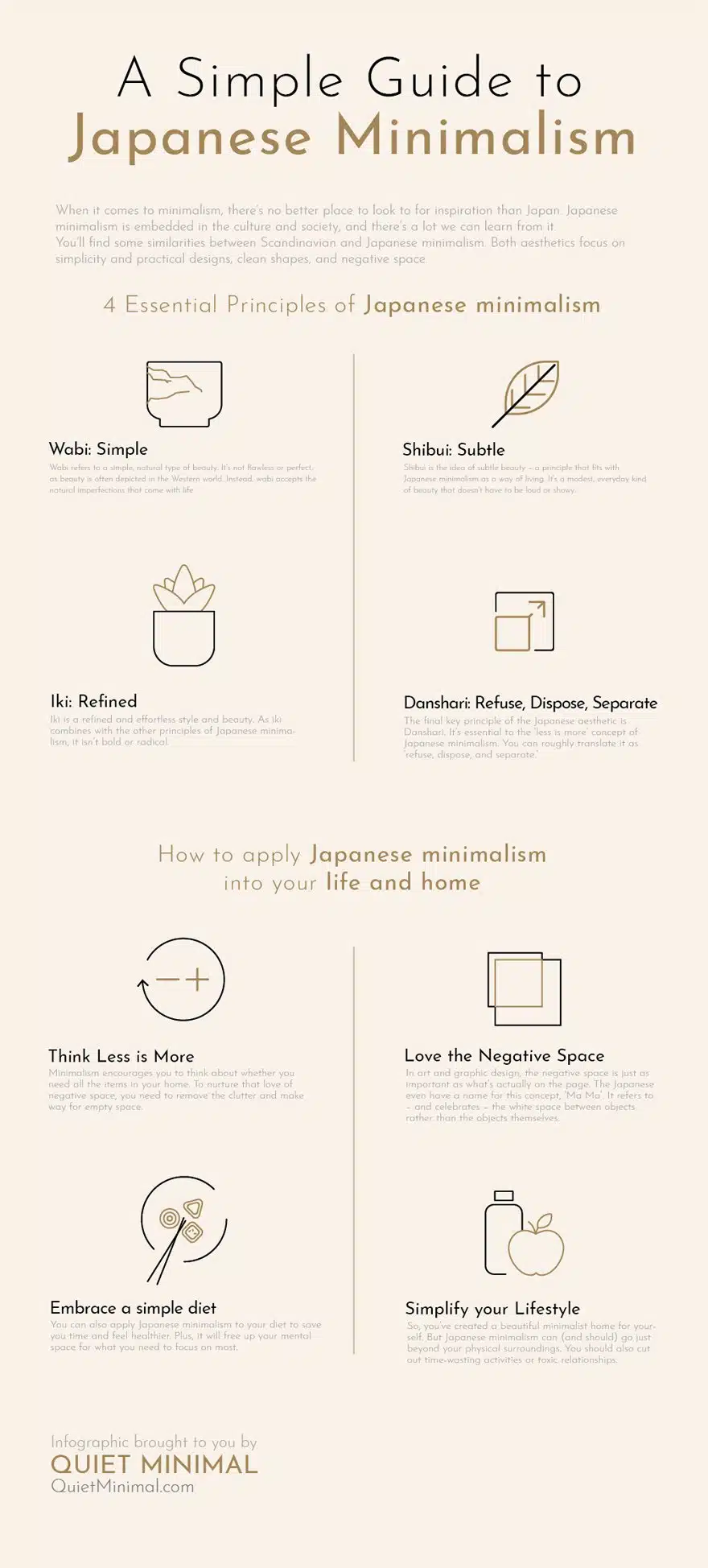
Final Thoughts
Japanese minimalism is a distinct form of minimalism with its own rich history. But there are some easy ways you can apply this minimalist attitude to your home, diet, and lifestyle.
The key principles of Japanese minimalism are simple, subtle, and refined beauty. Try to keep these concepts of Wabi, Shibui, and Iki in mind for your own home.
Danshari is also vital. It’s only by decluttering that you can create that essential negative space.
Japanese minimalism is a way of life that goes beyond interior design. If you embrace these minimalist concepts, you’ll find that they affect every aspect of your life.
As a result, you’ll free up mental space, reduce stress, and have more time for what brings you joy.
Let me know what you thought of this article below! Don’t forget to share on social media if you found it helpful or interesting!
